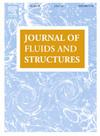Exploring optimal spacing in parallel fully-passive flapping-foil hydrokinetic turbines
IF 3.4
2区 工程技术
Q1 ENGINEERING, MECHANICAL
引用次数: 0
Abstract
The increasing global demand for sustainable energy has led to the exploration of hydrokinetic systems, particularly flapping foil turbines, which utilize fluid–structure interactions to harvest energy from water flows. This study investigates the optimization of spacing between fully passive oscillating foils arranged in parallel configuration to maximize energy extraction efficiency. Utilizing numerical simulations with OpenFOAM’s overset mesh and URANS methods, the research examines the hydrodynamic performance and interaction effects of varying foil spacings, ranging from 3 to 15 chord lengths. For a specific configuration of a stall-flutter flapping foil turbine, results reveal that closer spacings (e.g., 3 chord lengths) can achieve comparable results to single-foil configurations, with solo efficiency and parallel efficiency . The study further identifies a 15% increase in mean power coefficient at a spacing of , linked to higher heave amplitude and strong fluid–structure interactions. The study highlights the potential of dual-foil setups to improve structural integrity and adaptability in diverse natural water currents. These findings offer valuable insights for the design and operation of hydrokinetic turbines, enhancing their feasibility as a sustainable energy solution.
平行全被动扑翼水动力涡轮机的最佳间距探索
全球对可持续能源的需求不断增长,导致了对水动力系统的探索,特别是扑翼涡轮,它利用流固相互作用从水流中获取能量。为了使能量提取效率最大化,研究了全无源振荡箔并联布置的间距优化问题。利用OpenFOAM的overset mesh和URANS方法进行数值模拟,研究了不同箔间距(从3到15弦长)的水动力性能和相互作用效果。对于失速扑动翼型涡轮的特定配置,结果表明,更小的间距(例如3弦长)可以获得与单翼配置相当的结果,单翼效率η=0.299,并联效率η=0.304。该研究进一步确定,在d * =5的间距处,平均功率系数增加15%,这与较高的升沉幅度和强的流体-结构相互作用有关。该研究强调了双箔装置在提高结构完整性和适应不同自然水流方面的潜力。这些发现为水动力涡轮机的设计和运行提供了有价值的见解,提高了它们作为可持续能源解决方案的可行性。
本文章由计算机程序翻译,如有差异,请以英文原文为准。
求助全文
约1分钟内获得全文
求助全文
来源期刊

Journal of Fluids and Structures
工程技术-工程:机械
CiteScore
6.90
自引率
8.30%
发文量
173
审稿时长
65 days
期刊介绍:
The Journal of Fluids and Structures serves as a focal point and a forum for the exchange of ideas, for the many kinds of specialists and practitioners concerned with fluid–structure interactions and the dynamics of systems related thereto, in any field. One of its aims is to foster the cross–fertilization of ideas, methods and techniques in the various disciplines involved.
The journal publishes papers that present original and significant contributions on all aspects of the mechanical interactions between fluids and solids, regardless of scale.
 求助内容:
求助内容: 应助结果提醒方式:
应助结果提醒方式:


